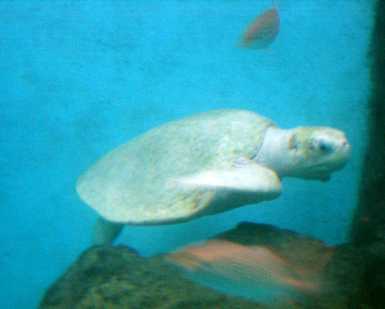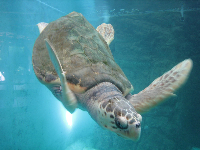
Kemp’s Ridley Sea Turtle,
El Centro de la Tortuga, Mazunte, Mexico
(#0092)

Hawksbill Sea Turtle,
el Centro de la Tortuga,
Mazunte, Mexico
(#0091)
|
El Centro de la
Tortuga
1473 words
A Visit To the Turtle Sactuary, Mazunta, Mexico
by Dianne Roth
In my life, the mention of turtle soup has not triggered a rush of salivary eagerness. Unfortunately, that is not true of a large portion of the world’s population. Sea turtles, long thought to be a renewable resource, have declined to the point of verging on extinction.
On a recent trip to Oaxaca in southern Mexico, a friend suggested taking a trip over the mountains to Puerto Angel (Aun-hell) on the Pacific Coast. It is only a half an hour flight from Oaxaca City to Huatulco on the coast, but we decided to take the nine hour night bus over winding, mountainous roads to Pochutla and a taxi to our hotel, La Casa Arnel, in Puerto Angel.
Arriving at 6:00 am, we were greeted with tropical scents and a deliciously warm breeze on our skin. We checked into our hotel and were in the water by 7:00 am. I tell friends that I floated in the Pacific Ocean for four days. But there was more. Between home cooked huevos Mexicanos for breakfast and sautéed dorado, a locally caught fish with mounds of garlic for dinner, we wandered and sketched this lovely oceanside village.
Over dinner one evening, a young biology student told us about his class’ previous night’s visit to witness thousands of turtles laying eggs along a nearby beach. We were eagerly planning our all-night beach odyssey before it was explained to us that it was next to impossible for anyone to be on the beaches during turtle egg laying. In fact the turtles and eggs are protected from poachers by federal soldiers armed with M-16 machine guns!
Instead, we were given directions to el Centro de la Tortuga in Mazunte, the Mexican National Center for Turtles, only a few kilometers west along the San Antonio Federal Highway.
Because of the high demand for the eggs, meat, oil, and shells, 50,000 turtles a year were killed and hundreds of thousands of eggs collected. Mazunte’s primary economy was based on harvesting and marketing turtle products. In fact, Mazunte translated from the local Nahuatl language means “please lay eggs”. Turtle soup and turtle steaks are a delicacy around the world and the eggs are considered a strong aphrodisiac. The shells have been turned into hair ornaments, rims for glasses, and other decorative items.
The seriously declining numbers of turtles returning to lay eggs along these beaches and around the world resulted in Mexico officially banning the killing of turtles and the collecting of eggs in 1990. Illegal harvesting has continued, and along with the mortality from predators, accidental ensnarment in fishing nets, and pollution, has kept the turtles on the endangered list.
In 1991, Centro Mexicano de la Tortuga was formed. The idea was to give the responsibility for the turtle’s survival to the very people whose economy had depended on harvesting the turtles. Along with tourism, the Turtle Center has helped start an agriforestry business and a chicken farm to replace the income the locals have lost from harvesting turtles.
The next morning after an early swim at Playa Panteon, we flagged down a taxi and were dropped off at the entrance to the Turtle Sanctuary. Our group of about 12 international visitors were met by Ivan, a young volunteer at the Turtle Center. Tours here are always guided by staff or volunteers. He started by giving us some interesting information about turtles.
All species of sea turtles that breed along the Oaxaqueña coastline are on display in Mazunte. They are the green turtle, white turtle, hawksbill, leatherback, and olive ripley (golfina). In addition, they have 6 species of freshwater turtles and 2 species of land turtles in exhibits.
Depending on the species, sea turtles can range from two feet long and 30 pounds up to the leatherback that can grow as long as eight or nine feet and can weigh nearly a ton. Hawksbill turtles are ready to breed at three years, but the green turtle only begins to breed after as many as 30 years. The larger turtles can live as long as 80 years. Some sea turtles are vegetarian, others enjoy a diet of shellfish and jellyfish.
Sea turtles, like salmon, swallows, and monarch butterflies, return to the place they were born to lay their eggs. Scientists theorize that the baby turtles imprint on the kind of sand, temperature, and landmarks in order to find their way back to the right beach. A metallic mineral is also found the turtle’s brain which may help them use magnetism to pinpoint where they were born.
Escobilla Bay, near Mazunte, is one of the main egg laying beaches for the olive ripley or the golfina turtle. Historically, the turtles come ashore by the thousands on the three to four days after a full moon. These mass nestings are called “arribadas” or arrivals. They climb a few feet above the water line, dig a two foot deep hole, and lay up to 200 eggs. Finished laying the eggs, the females cover the holes and return to their feeding grounds in the ocean. Many return to lay eggs several times between May and January. After 6 to 10 weeks, the babies hatch and spend three to four days climbing through the sand to the surface. Survival rate for the babies is low.
Volunteers at the center spend nights along the beach collecting freshly laid eggs. The mother turtle is apparently in a trance once she begins laying the eggs and is undisturbed by the volunteers removing her eggs. The ping pong ball sized eggs are taken to the center to be incubated in sand filled plastic buckets. Scientists have discovered that the sex of the baby turtle is determined by the temperature of the sand. Warmer sand produces more females, cooler sand, more males.
Ivan lead us around to the back of the center where he showed us several tanks. The first held hundreds of “teenage” turtles waiting to be released along the beach where they were collected. The scientists believe that the babies need a certain amount of “sand time” to imprint the location so are released above the water line. Another tank was full of newborns, a mere 2 to 3 inches in diameter. They reminded me of my own little turtle that lived under a plastic palm tree when I was a child. Baby turtles carry salmonella and are, fortunately, no longer considered suitable pets. Other tanks had hawksbill, green, blanco (white), and golfina turtles. They were about 18” in diameter. Some were full grown, some just babies. All were graceful swimmers soaring around the tank, more like birds than the prehistoric reptiles they are.
Ivan spent more than an hour sharing turtles, answering questions, and practicing his English. He confessed to loving the turtles and sincerely felt that he was making a difference in their path to extinction.
We relaxed in the open air gift and snack shop. I enjoyed a bit of tamarind leather, a tartly sweet treat that was well worth the mess of eating it and worked on my sketches of turtles.
We returned to Puerto Angel by way of colectivo, an inexpensive taxi that stops along the way and picks up additional fares. There were six of us packed into that little sedan. Later we wandered down to the beach and floated in the turtle’s home environment, each of us touched by and filled with an awe for this amazing animal. I nearly cried when Ivan told us that plastic bags floating in the ocean resemble the jellyfish many sea turtles eat. How sad that this magnificent animal starves to death after eating our tossed or blown away trash.
We were still disappointed that we would not be able to spend the night on the beach watching these gentle marvels from the sea lay their eggs. Being a part of this ritual that has happened on these very beaches since the Jurassic Period, 200 million years ago, could have been a life-changing experience. I just hope that the work of the Centro de la Tortuga in Mazunte will be able to ensure that this ritual will continue for a long time to come.
I cannot imagine a world without the sea turtle.If you go: Consider flying to Huatulco. You can drive or take a bus. The road to Pochutla by bus is picturesque, but long, curvy, and prone to inducing car sickness. Puerto Angel and Mazunte are northwest and easily reached by bus, taxi, or colectivo.
The Turtle Center is open every day except Monday. Guided tours are given in English, German, Italian, Spanish and Zapoteco. Use Google to search for Mazunte+turtle for lots more information.
Dianne Roth is a teacher, mother, grandmother, and freelance
writer. She lives in Oregon.
|
|




